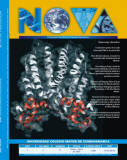Frequency of Nosocomial enterobacterial b-lactamase-Producing of extended Spectrum, cumana, Venezuela
Frecuencia de enterobacterias nosocomiales productoras de b-lactamasas de espectro extendido, Cumaná, Venezuela
Issue
Section
Artículo Original
How to Cite
Albarado Ysasis et al., L. S. (2009). Frequency of Nosocomial enterobacterial b-lactamase-Producing of extended Spectrum, cumana, Venezuela. NOVA, 7(11). https://doi.org/10.22490/24629448.417
Dimensions
license
NOVA by http://www.unicolmayor.edu.co/publicaciones/index.php/nova is distributed under a license creative commons non comertial-atribution-withoutderive 4.0 international.
Furthermore, the authors keep their property intellectual rights over the articles.
Show authors biography
Article visits 209 | PDF visits 133
Downloads
Download data is not yet available.
- Guinan JL, McGuckin M, Shubin A, Tighe J. A descriptive review of malpractice claims for health care-adcquired infections in Philadelphia. Am J Infect Control. 2005;33:310-312.
- Casellas J. Resistencia bacteriana por producción de b-lactamasas de espectro extendido: La perspectiva global y latinoamericana en el escenario hospitalario. Reunión de consenso-La aparición de microorganismos productores de ESBL en América Latina: Recomendaciones para su control y tratamiento (Sao Pablo, Brasil). Infec Dis Clin Pract. 2001;12-16.
- Díaz R, Solórzano F, Padilla G, Miranda M, González R, Trejo J. Infecciones nosocomiales. Experiencia en un hospital pediátrico de tercer nivel. Salud Púb Mex. 2001;41:12-17.
- Owens R y Rice L. Hospital-based strategies for combating resistance. Clin Infect Dis. 2006;42:S173-181.
- Herrera K, Espinoza M, Mejía Y, Zambrano L, Silva E, Rojas J, Gadea W, Cavaría S, Hernández M, Ramírez M, Membreño J, Lara M, Saenz J, Valle S, Torrez A, Carera E, Cáceres M. Resistencia antimicrobiana en Hospitales nor-occidentales de Nicaragua. Universitas. 2007;1:27-32.
- Goodman R. y Gilman J. Las bases farmacológicas de la Terapéutica. Novena edición. Editorial Médica Panamericana. Buenos Aires. 1999.
- Ambler R. The structure of beta-lactamases. Philos Trans R Soc Lond B Biol Sci. 1980;289:321-331.
- Bush K, Jacoby G, Medeiros A. A functional classification scheme for ß-lactamases and its correlation with molecular structure. Antimicrob Agents Chemother. 1995;39:1211-1233.
- Rice L. Evolution and Clinical Importante of Extended-Espectrum b-Lactamases. Chest. 2001;119:391-396.
- Bradford P. Extended-spectrum b-lactamases in the 21st century: characterization, epidemiology, and detection of this important resistance threat. Clin Microbiol Rev. 2001;14:933-935.
- Clinical and Laboratory Standards Institute (CLSI). Performance Standards for Antimicrobial Susceptibility Testing; Fifteenth Informational Supplement. 2007; 25:178.
- Blásquez J, Baquero M, Canton R, Alos I, Baquero F. Characterization of a new TEM-type b-lactamase resistant to clavulanate, sulbactam and tazobactam in a clinical isolate of Escherichia coli. Antimicrob Agents Chemother. 1993;37:2059-2063.
- Murria P, Baron E, Jorgensen J. Manual of Clinical Microbiology. Octava edición. ASM USA. 2003.
- Horan TC, Andrus M, Dudeck MA. CDC/NHSN surveillance definition of health care-associated infection and criteria for specific types of infections in the acute care setting. Am J Infect Control 2008;36:309-332.
- Koneman E, Allen S, Janda W, Schreckenberger P, Washington, W. Diagnóstico Microbiológico. Quinta edición. Editorial Panamericana. 2002.
- Mac Faddin J. Pruebas bioquímicas para la identificación de bacterias de importancia clínica. Quinta edición. Editorial Panamericana. Buenos Aires. 2003.
- Huccker G. y Coon H. Methods of Gram Staining. Technical Bulletin New Cork State Agricultura Experimentation. 1923;93:1-
- 18. Bauer A, Kirby W, Sherris J, Turck M. Antibiotic susceptibility testing by a standardized single disk method. Am J Clin Pathol. 1966;45:493-496.
- Crespo M. La lectura interpretativa del antibiograma: Una herramienta para predecir la resistencia bacteriana en el laboratorio de microbiología de rutina. Colomb Med. 2002;33:179-193.
- Jarlier V, Nicolas M, Fournier G, Philippon A. Extended broadspectrum b-lactamases conferring resistance to newer b-lactam agents in Enterobacteriaceae: hospital prevalence and susceptibility patterns. Rev Infect Dis. 1989;10:867-878.
- Dawsen S. y Robert G. Bioestadística Médica. Editorial el Manual Moderno S.A. México DF. 1997.
- Martín G, Carmona O, Guzmán M. Infección nosocomial II: Resistencia a ß-lactámicos y aminoglucósidos en Pseudomonas aeruginosa en centros médicos de Venezuela durante el año 2000. Rev Soc Ven Microbiol. 2003;23: 183-189.
- Alpuche M. y Daza C. Infecciones nosocomiales por bacterias Gram negativas resistentes a cefalosporinas de espectro extendido: edan asociación de dos peligrosos enemigos. Enf Infec y Microbiol. 2002;22:192-199.
- Pérez C. Antimicrobianos en Unidades de Cuidados Intensivos: Uso empírico. Rev chil Infectol. 2003;20:70-73.
- Poveda L, Villamizar D, Sánchez F, Otta A, Guevara C, Jiménez M, Besso J. Infecciones nosocomiales en terapia intensiva. Antib Infect. 2005;2:40.
- Muzachiodi M, Ferrero S. Incidencia de enterobacterias productoras de betalactamasas de espectro extendido en el Hospital Escuela José F. de San Martín. Facultad de Cs. Exactas Nat. y Agrim. Dpto. de Bioquímica. Argentina. 2005.
- Martínez P, Mercado M, Máttar S. Determinación de b-lactamasas de espectro extendido en gérmenes nosocomiales del Hospital San Jerónimo, Montería. Colomb Med. 2003;34:130-139.
- Cornejo P, Velásquez C, Sandoval S, Gordillo P, Volkow P. Patrones de resistencia bacteriana en urocultivos en un hospital oncológico. Salud Púb Méx. 2007;49:330-336.
- Perozo-Mena A, Castellano-González M, Ginestre-Pérez M, Harris B. Caracterización Molecular y Detección de Betalactamasas de Espectro Extendido en Cepas de E. coli y K. pneumoniae Aisladas en las Unidades de Cuidados Intensivos de un Hospital Universitario. Kasmera. 2007;35:91-106.
- Araya C, Boza R, Arguedas L, et al. Infecciones nosocomiales por bacterias productoras de betalactamasas de espectro ampliado: prevalencia, factores de riesgo y análisis molecular. Acta Méd Costarric.
- ;49:90-96.
- Torres L, Gagliotta V, Torres O, Benítez M, Domínguez M, Pedroza R. b- Lactamasas de Espectro Expandido en Enterobacterias aisladas en Centros de Salud de Caracas. Rev Soc Ven Microbiol. 2006;26:190-205.
- Livermore D. b-lactamases in laboratory and clinical resistance. Clin Microbiol Rev. 2000;8:557-584.
- Famiglietti A, Quinteros M, Vázquez M, Marín M, Incola F, Radice M. Consenso sobre las pruebas de sensibilidad a los antimicrobianos en Enterobacteriaceae. Rev Argent Microbiol. 2005;37:57-66.
- Cortés J, Urdaneta A, Potdevin G, Cuervo S, Bermúdez D, Molina C, Arroyo, P. Impacto de las betalactamasas de espectro extendido en pacientes con cáncer. Rev Colomb Cancerol. 2006;10:183-196
- -------------------------------------------------------------------------------
- DOI: http://dx.doi.org/10.22490/24629448.417






